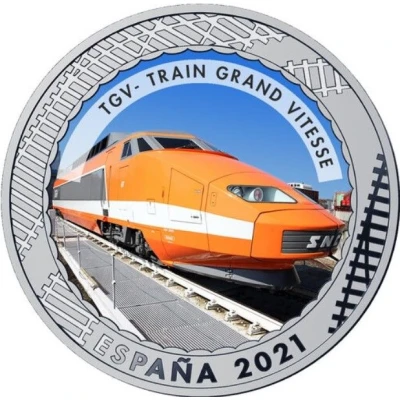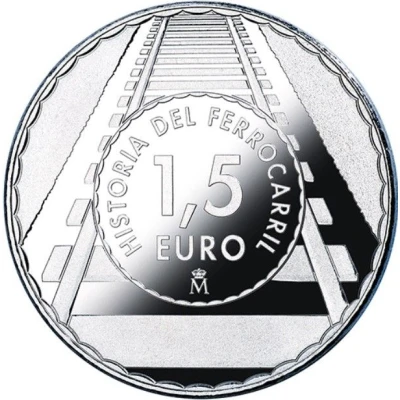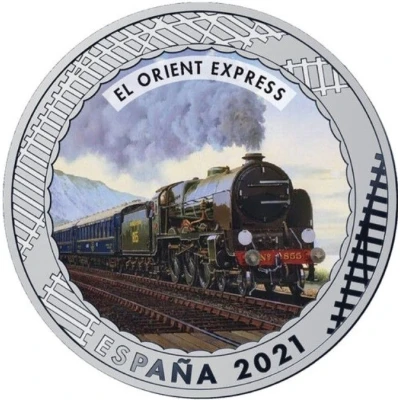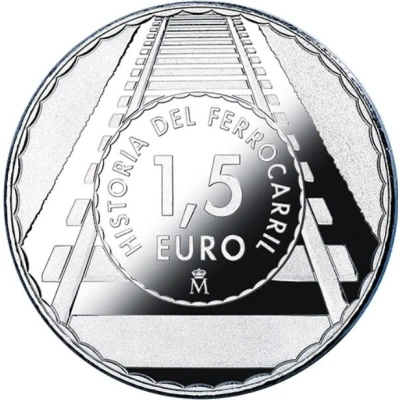


© Real Casa de la Moneda
1.5 Euro TGV - Train Grand Vitesse
2021 year| Copper-nickel (75% copper, 25% nickel) | 15 g | 33 mm |
| Issuer | Spain |
|---|---|
| King | Felipe VI (2014-date) |
| Type | Non-circulating coin |
| Year | 2021 |
| Value | 1.5 Euro 1.50 EUR = USD 1.65 |
| Currency | Euro (2002-date) |
| Composition | Copper-nickel (75% copper, 25% nickel) |
| Weight | 15 g |
| Diameter | 33 mm |
| Shape | Round |
| Technique | Milled, Coloured |
| Orientation | Medal alignment ↑↑ |
| Updated | 2024-10-07 |
| Numista | N#320112 |
|---|---|
| Rarity index | 90% |
Reverse
Series and face value inside a central circle. Outside the central circle, an image of a railway track.
Script: Latin
Lettering:
HISTORIA DEL FERROCARRIL
1,5 EURO
M
Translation: History of railways
Edge
Plain
Comment
For the year 2021, since the European Year of the Rail and the 80th Anniversary of Renfe are celebrated, the FNMT-RCM issues a collection of 20 coins dedicated to the History of the Railways. This series reproduces a selection of trains and locomotives that have been relevant throughout its history.TGV – TRAIN GRANDE VITESSE: Within Europe, it was in France where the first trials took place for the construction of a high-speed railway, culminating in 1981 with the inauguration of the TGV-Sudeste on the Paris-Lyon route, although it would not come into full operation until 1983. The idea was born as a result of excess traffic problems arising on the Paris-Lyon-Mediterranée (PLM) line, prompting the French railway company, the SNCF, to build a new railway line where trains could reach speeds of over 300 km/h.
After a first trial with turbine locomotives in the mid-1960s, the French government, under pressure deriving from the financial cost involved and the burgeoning financial crisis, opted for electric traction to increase the service between Paris and Lyon.
In 1978, French railway tracks started to carry the first convoys: specifically, a power car designed on similar lines to its predecessor, the gas turbine, with 8,450 hp (6.300 kW). Alstom took on the construction of the power cars in Belfort and the trailer coaches in La Rochelle.
Six of the carsets were polyvalent in that they could be powered at 1.500 V CC and at 15,000 V AC, each power unit being equipped with a transformer with an independent thyristore rectifier for each one. The aim was to prevent the failure of more than one engine at the same time and have the thyristores act as choppers to control the engine’s continuous current voltage.
Each TGV carset was made up of two articulated power cars, mounted on a common bogie. The train had a total of eight articulated cars and a power car with its streamlined nose at each end, with Bo-Bo axles and electric engines mounted on the bodywork. In addition, it featured a dynamic system and a disc and brake pad, used respectively when travelling at over 300 km/h and to clean the wheel rims. It began its operative life with a top speed of 270 km/h.
Interesting fact
The TGV (Train Grand Vitesse) coin has a unique train-shaped design, which represents the high-speed rail network in Spain.
Price
| Date | Mintage | VG | F | VF | XF | AU | UNC |
|---|---|---|---|---|---|---|---|
| 2021 M | 7000 | - | - | - | - | - | - |
Values in the table are based on evaluations by sales realized on Internet platforms. They serve as an indication only for 1.5 Euro (TGV - Train Grand Vitesse) 2021 coin.



